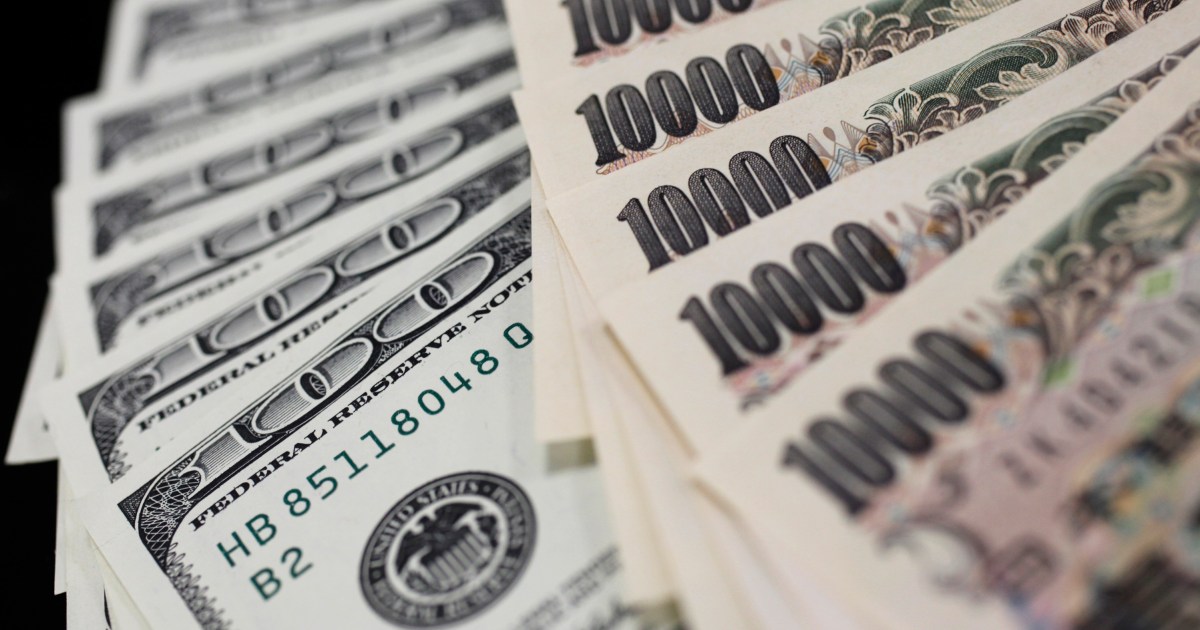Why is Japan’s yen so weak against the US dollar? | Financial Markets
The weakness of the Japanese yen is in the spotlight again after its latest tumble in value.
On Monday, the currency sank to 160.17 against the US dollar, its lowest since April 1990.
The yen recovered to 155.01 per dollar later in the day, prompting speculation that Japanese authorities had intervened to prop up the value of the currency.
The yen weakened slightly again on Tuesday, but held onto most of the previous day’s gain.
Why is the yen falling?
The value of a country’s currency rises and falls relative to currencies elsewhere in line with the laws of supply and demand.
At the moment, investors are being driven to offload the yen due to a yawning gulf in interest rates between Japan and the United States.
While the US Federal Reserve’s benchmark interest rate is currently set at 5.25-5.50 percent, the Bank of Japan’s (BOJ’s) equivalent rate is just 0-0.1 percent.
“The main driver is the rate differential between the US and Japan,” Min Joo Kang, senior economist for South Korea and Japan at ING, told Al Jazeera.
“Also, market expectations rapidly changed on the Fed’s monetary policy.”
The gap in interest rates reflects the very different inflation environments in the US and Japan. While Japan has struggled to get prices and wages to rise after decades of economic stagnation, the US has been battling to bring prices down amid robust economic growth.
For investors, higher interest rates in the US mean an opportunity to make much higher returns on investments, such as government bonds, in that country than they can in Japan.
The more investors sell the yen, the more it declines in value – encouraging investors to keep selling in a self-perpetuating cycle.
Is this a new phenomenon?
Actually, it is part of a longstanding trend.
While the yen’s decline has been especially severe of late, the currency has been on a continual slide since early 2021.
Over the last three years, the yen has lost more than one-third of its value.
The currency is now back to where it was following the collapse of a huge asset bubble in the early 1990s.
While other countries have raised interest rates to tame inflation that spiked during the COVID-19 pandemic, Japan has maintained rock-bottom borrowing costs in an effort to shake the economy out of a prolonged stagnation known as “the lost decades”.
Although the BOJ last month hiked the benchmark rate for the first time in 17 years, Asia’s second-largest economy is still an outlier globally.
Why does it matter that the yen is so weak?
A weak currency is a mixed bag for the economy.
Japan’s weakening yen has helped boost exporters’ profits by making their products cheaper to buyers overseas.
The slide has also encouraged a record influx of foreign tourists – there were 3.1 million visitors to the country in March alone – whose spending helps support local businesses.
But the yen’s slump has sharply raised the cost of imports, particularly food and fuel, putting a strain on household budgets.
The advantage of a falling yen for exporters has also been dampened by the fact that many large Japanese companies carry out a significant portion of their operations overseas.
What can Japan do about it?
Japanese officials have repeatedly expressed concern about the yen’s excessive depreciation and indicated they are prepared to intervene if necessary.
Authorities can pull on two main levers: buying up the yen or raising interest rates.
On Monday, the sudden surge in the yen’s value prompted speculation that authorities had stepped into the currency markets to arrest its slide, which would be the first such intervention since late 2022.
Japanese authorities have not confirmed intervening in the market and official figures that would reveal whether they did so will not be available until late May.
Still, momentum appears to be against any substantial strengthening of the yen in the foreseeable future.
During its intervention in 2022, Japanese authorities spent more than $60bn of its foreign exchange reserves to prop up the yen – only to see it continue its slide.
Meanwhile, the large gap between Japanese interest rates and those elsewhere is likely to persist for some time.
While BOJ Governor Kazuo Ueda has indicated that the central bank could raise rates if inflation picks up, price growth has slowed in recent months.
On Friday, the BOJ held interest rates steady, bolstering expectations that its ultra-loose policy is here to stay.
Meanwhile, the US Fed’s recent signals have dampened expectations that significant interest rate cuts are on the cards this year amid persistently stubborn inflation.
ING’s Kang said she expects the yen’s weakness to continue over the coming months.
“We believe that forex intervention by the Japanese authorities only can slow down the depreciation pace, but cannot change the direction of the currency move,” she said.
“To change the course of the yen’s path, either the BOJ should suddenly strengthen its hawkish voices – we believe this is not likely – or the Fed should give a more clear sign of rate cuts. This also not likely in the near term.”
Check out our Latest News and Follow us at Facebook
Original Source







